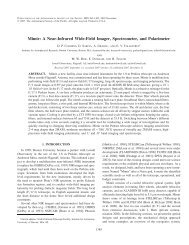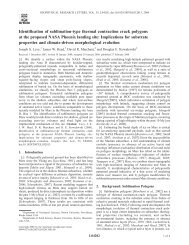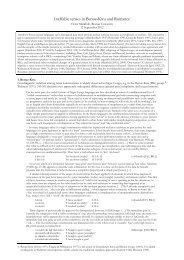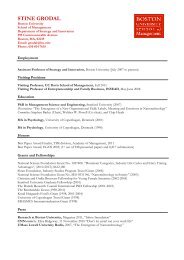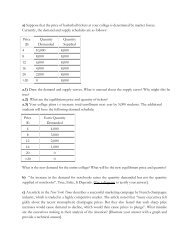which is strictly increasing in the second argument. Then we have<strong>and</strong> hence,(∫V (c, a) = W(c, u −1 ◦ φ −1Ŵ (c, ζ(z)) = W (c, u −1 ◦ φ −1 (z)), (42)φL(∫Let v = φ ◦ u. We obtain representation (18).C2. Extension to the Whole Domainu(V (c ′ , a ′ ))dl(c ′ , a ′ )C×∆(L))))da(l) .Define V s t : C × ∆(H) by:V s t(c, p) = V (c, a), (43)for each (c, p) ∈ C × ∆(H), where a ∈ ∆(L) is such that (c, p) ∼ s t(c, a). The existenceof such a risk equivalent a follows from Lemma 9, Dynamic Consistency, compactness of C,<strong>and</strong> continuity of ≽ s tderive:(see Lemma 9 in Hayashi (2005)). Using definition (43) <strong>and</strong> (37), weV s t(c, p) = V (c, a) = Ŵ (c, V (ĉ, m)) = Ŵ (c, V st(ĉ, p)). (44)Our axioms B1, B4, B5 <strong>and</strong> B7 when restricted to ∆(H +1 ) satisfies the conditions inTheorem 4.2 in Seo (2009).By this theorem, V s t(ĉ, ·) restricted to ∆(H +1 ) is ordinallyequivalent to a second-order subjective expected utility representation, <strong>and</strong> hence has theform:<strong>and</strong>∫U s t(h +1 ) =(∫)V s t(ĉ, p +1 ) = ζ s t U s t(h +1 )dp +1 (h +1 ) , (45)H +1P s tφ s t( ∑s∈S∫)π(s) û s t(c ′ , a ′ )dh +1 (s)(c ′ , a ′ ) dµ s t(π), (46)C×∆(L)where ζ s t <strong>and</strong> φ s t are strictly increasing functions <strong>and</strong> û s t is a v-NM index. By Axiom B6(Dynamic Consistency) <strong>and</strong> a similar argument in Appendix A1, û s tequivalent over C × ∆(L). Thus, there is a monotone transformation u s tfor every (c ′ , a ′ ) ∈ C × ∆(L).<strong>and</strong> V are ordinallysuch that:û s t(c ′ , a ′ ) = u s t(V (c ′ , a ′ )), (47)Equations (38) <strong>and</strong> (43) imply that on ∆(L),(∫ )(∫)ζ U(l)da(l) = V (ĉ, a) = V s t(ĉ, a) = ζ s t U s t(l)da(l) ,LL45
which in turn implies that on L,Hence, we deduce that:which implies that:ζ (U(l)) = V (ĉ, δ[l]) = V s t(ĉ, δ[l]) = ζ s t (U s t(l)) .U s t = ζ −1s t ◦ ζ ◦ U,(∫ ) (∫)ζ U(l)da(l) = ζ s t ζ −1s◦ ζ ◦ U(l)da(l) .tLLBy the additivity of integral formula, we haveζ −1s t◦ ζ (αx + (1 − α) y) = αζ −1s t◦ ζ(x) + (1 − α) ζ −1s t◦ ζ(y)for all x, y in the range of U <strong>and</strong> all α ∈ [0, 1]. Therefore ζ s t <strong>and</strong> ζ are identical up to positiveaffine transformations. Thus without loss of generality we can take ζ s t = ζ <strong>and</strong> U s t = U forall s t .Equations (39), (40), (46), <strong>and</strong> (47) imply that on L,(∫)φ u ◦ V (c ′ , a ′ )dl(c ′ , a ′ ) = U(l) = U s t(l)C×∆(L)(∫)= φ s t u s t ◦ V (c ′ , a ′ )dl(c ′ , a ′ ) ,C×∆(L)which in turn implies that:φ ◦ u ◦ V (c ′ , a ′ ) = U(δ[c ′ , a ′ ]) = U s t(δ[c ′ , a ′ ]) = φ s t ◦ u s t ◦ V (c ′ , a ′ ).Hence, we have φ ◦ u = φ s t ◦ u s t, which implies that:(∫) (∫)φ u ◦ V (c ′ , a ′ )dl(c ′ , a ′ ) = φ s t φ −1s◦ φ ◦ u ◦ V (c ′ , a ′ )dl(c ′ , a ′ ) .tC×∆(L)C×∆(L)By the same reasoning as above, φ s t <strong>and</strong> φ are identical up to positive affine transformations.Therefore without loss of generality we can set φ s t = φ <strong>and</strong> u s t = u for all s t .Now, plugging equations (45), (46), <strong>and</strong> (47) into (44), we obtain that, on C × ∆(H +1 ),= Ŵ= WV s t(c, p +1 )( ( ∫ ∫H +1c, ζP s tφ( ∑s∈S(c, u −1 ◦ φ −1 ( ∫H +1∫P s t∫π(s)φ( ∑s∈SC×∆(L)∫π(s)u(V (c ′ , a ′ ))dh +1 (s)(c ′ , a ′ )46C×∆(L))u(V (c ′ , a ′ ))dh +1 (s)(c ′ , a ′ )dµ s t(π)dp +1 (h +1 ))))dµ s t(π)dp +1 (h +1 ))),
- Page 1: Intertemporal Substitution andRecur
- Page 6 and 7: As in KMM (2005, 2009a), we impose
- Page 8 and 9: 2. Review of the Atemporal ModelsIn
- Page 10 and 11: defined over it. Notice that by res
- Page 12: For any c ∈ C, we use δ[c] to de
- Page 15: The axiom below states that the pre
- Page 18: is ambiguity averse if he prefers a
- Page 22 and 23: Axiom B6 (Dynamic Consistency) For
- Page 24 and 25: 3. On the subdomain C × M, we obta
- Page 26 and 27: We can similarly define ambiguity l
- Page 28 and 29: epresentations under these two appr
- Page 30 and 31: where R t+1 is the market return fr
- Page 32 and 33: Segal (1987, 1990) and Seo (2009).
- Page 34 and 35: A Appendix: Proof of Theorems 1 and
- Page 36 and 37: Define v = ψ ◦ ū −1 ◦ u, wh
- Page 38 and 39: compute:∫˜ū (m) =∫=∫=∫= A
- Page 40 and 41: DefineH = {h = (h 0 , h 1 , h 2 ,
- Page 42 and 43: Lemma 5 We have the homeomorphic re
- Page 44 and 45: Finite-step-ahead acts and densenes
- Page 48 and 49: where the second equality follows f
- Page 50 and 51: D Appendix: Proofs for Section 4.4P
- Page 52 and 53: This relation holds true because i
- Page 54 and 55: In complete markets, the following
- Page 56 and 57: Ergin, H. I. and F. Gul (2009): “
- Page 58: Weil, P. (1989): “The Equity Prem



